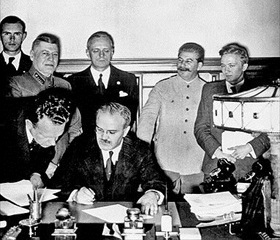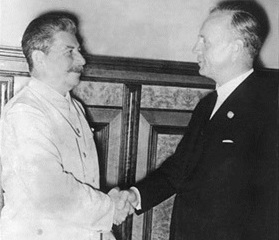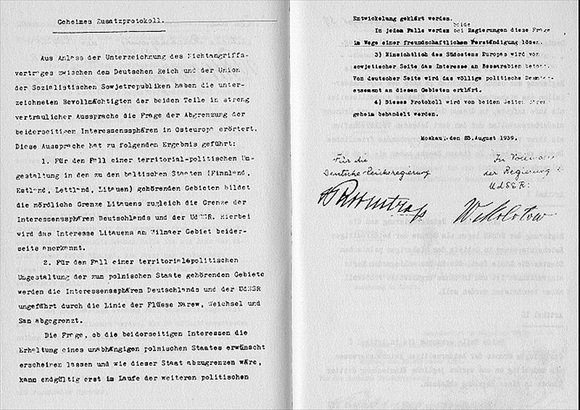STALIN SEIZES LATVIA, HITLER HALTS WAR AGAINST FRANCE
Munich, Germany · June 17, 1940
On this date in 1940 Joseph Stalin of the Soviet Union, drawing on provisions of the secret protocol in the August 1939 Molotov-Ribbentrop Nonaggression Pact with his Nazi ally, ordered an attack on the Baltic state of Latvia. (The 1939 protocol had already returned dividends to the two conspirator nations, allowing them to divide Poland between themselves within a month of the Soviet and German foreign ministers signing the pact named after them.) The next day, June 18, 1940, an official representative of Stalin’s arrived in the Latvian capital, Riga, to assume the reins of power. The incorporation of Latvia and the other two Baltic states, Lithuania and Estonia, into the Soviet Union was completed in early August 1940.
On the other side of the European continent, Adolf Hitler, Stalin’s co-conspirator, ordered the suspension of hostilities in France on this date, June 17, 1940, and the new French premier, Marshal Philippe Pétain, took to the nation’s airwaves, informing his fellow countrymen that negotiations for an armistice were in progress. The news was met with enthusiasm in the ranks of the Royal Italian Army (Regio Esercito) and in Italy, which had declared war on France and Great Britain just the week before. The hostilities were over; it was time to grab the “spoils” was how Italian strongman Benito Mussolini saw it. (An Italian skirmish with French defense forces on June 21 was designed to drive the point home.) Ever the opportunist, Il Duce (Italian, “the leader”), board a train to Munich to confer with Axis partner Hitler, generated a shopping list of materiel and territories he wanted for his country under the terms of the general armistice; for example, ships, aircraft, the island of Corsica, Tunisia in North Africa, etc.
On June 18 Mussolini and Hitler drew lines on a large military map of France that identified their future zones of occupation. They also agreed to separate armistice commissions: Hitler did not want his junior partner’s presence near the northern French city of Compiègne to intrude on the spectacular program he had choreographed for the French surrender—the armistice was to be signed in the same railway car in which the World War I Allied supreme commander, French Marshal Ferdinand Foch, had dictated peace terms to representatives of Kaiser Wilhelm II in 1918. Hitler and Germany had waited 22 years for this triumphant moment.
Molotov-Ribbentrop Nonaggression Pact with Secret Protocol, Moscow, August 23–24, 1939
 |  |
Left: Soviet Foreign Minister Vyacheslav Molotov signs the German-Soviet Nonaggression Pact. Immediately behind him is German Foreign Minister Joachim von Ribbentrop and, to the German’s left, is Soviet leader Joseph Stalin. The Kremlin, Moscow, August 24, 1939.
![]()
Right: Stalin congratulates Ribbentrop with a warm handshake following the signing ceremony. The pact, largely seen as Stalin’s brainchild, marked the first time the Soviet dictator had been personally involved in formulating and negotiating foreign policy.
![]()
Below: The Molotov-Ribbentrop Nonaggression Pact contained a secret protocol (Geheimes Zusatzprotokoll) that was revealed only after Germany’s defeat in 1945. Under its terms Romania, Poland, Lithuania, Latvia, Estonia, and Finland were to be divided into German and Soviet “spheres of influence.” Finland, Estonia, and Latvia were assigned to the Soviet sphere. Poland was to be partitioned after Hitler’s invasion of that country, which came on September 1, 1939. Thus, the western half of Poland was occupied by Germany and the eastern half of Poland came under Soviet occupation, partitioned after the war between Byelorussian Soviet Socialist Republic (today’s Belarus) and Ukrainian Soviet Socialist Republic (today’s independent Ukraine). A second secret protocol assigned the majority of Lithuania, which bordered on Germany’s East Prussia, to the Soviet Union.
 |
Molotov-Ribbentrop: The Pact That Changed Europe’s Borders
![]()

 History buffs, there is good news! The Daily Chronicles of World War II is now available as an ebook for $4.99 on Amazon.com. Containing a year’s worth of dated entries from this website, the ebook brings the story of this tumultuous era to life in a compelling, authoritative, and succinct manner. Featuring inventive navigation aids, the ebook enables readers to instantly move forward or backward by month and date to different dated entries. Simple and elegant! Click
History buffs, there is good news! The Daily Chronicles of World War II is now available as an ebook for $4.99 on Amazon.com. Containing a year’s worth of dated entries from this website, the ebook brings the story of this tumultuous era to life in a compelling, authoritative, and succinct manner. Featuring inventive navigation aids, the ebook enables readers to instantly move forward or backward by month and date to different dated entries. Simple and elegant! Click 











